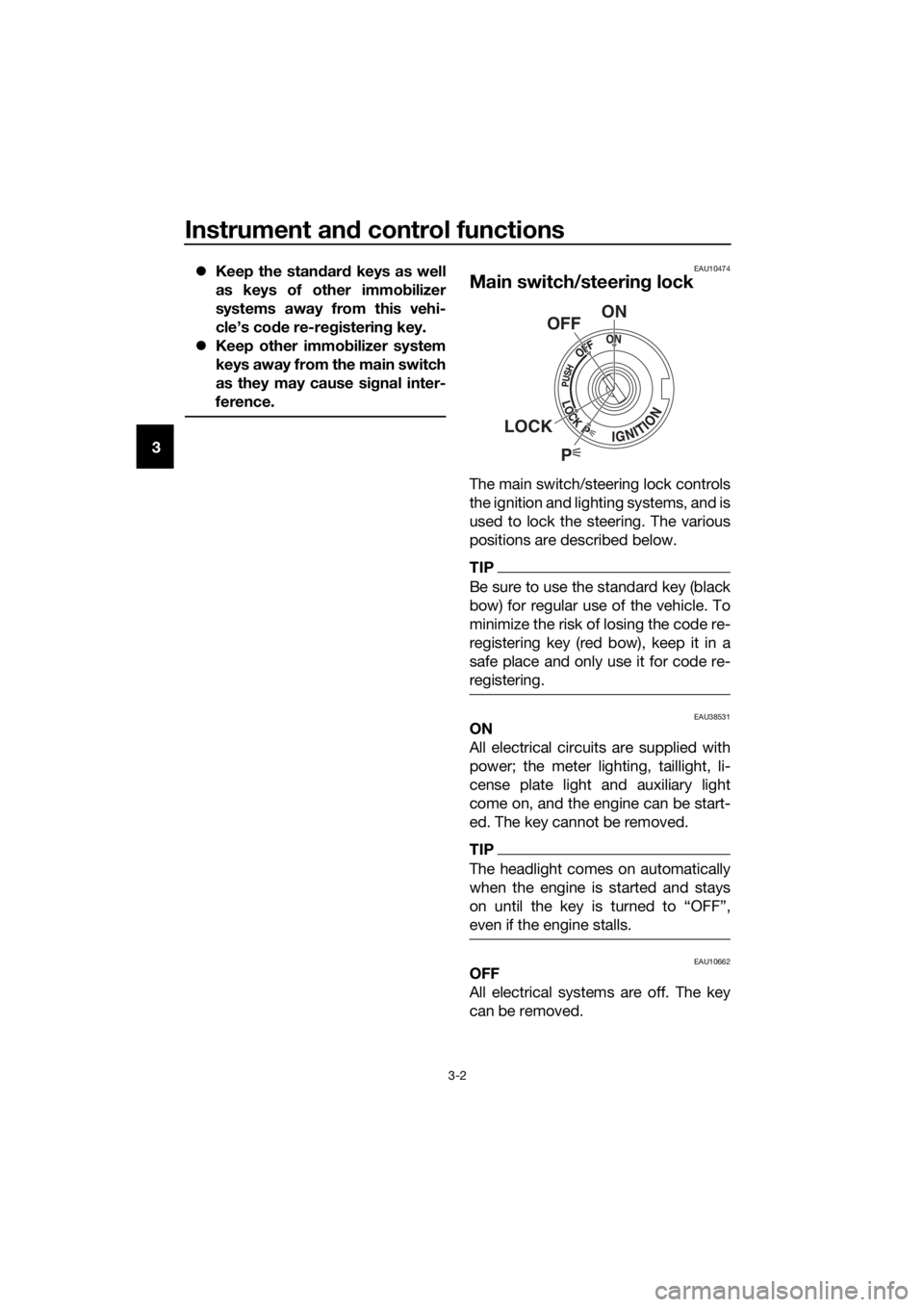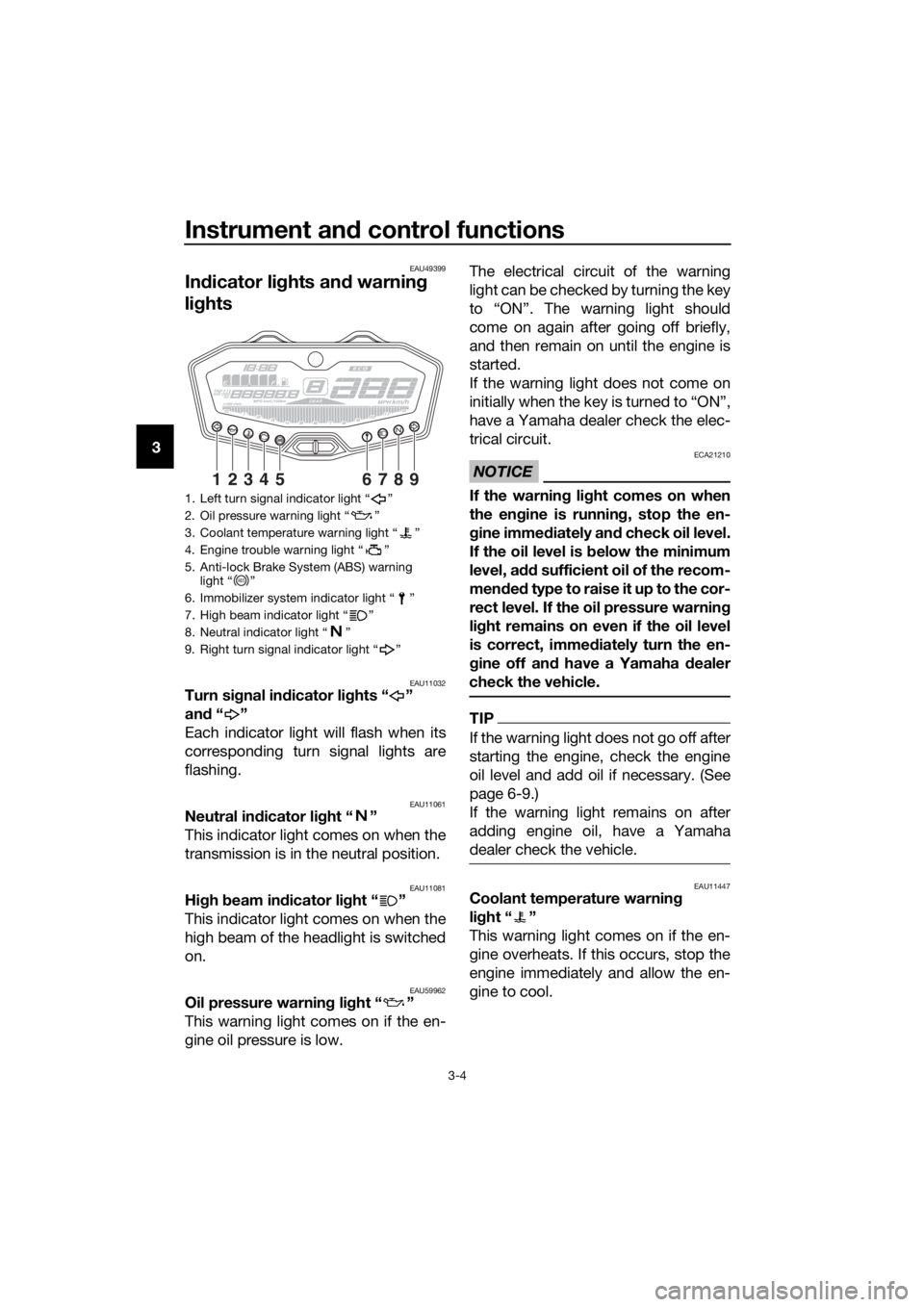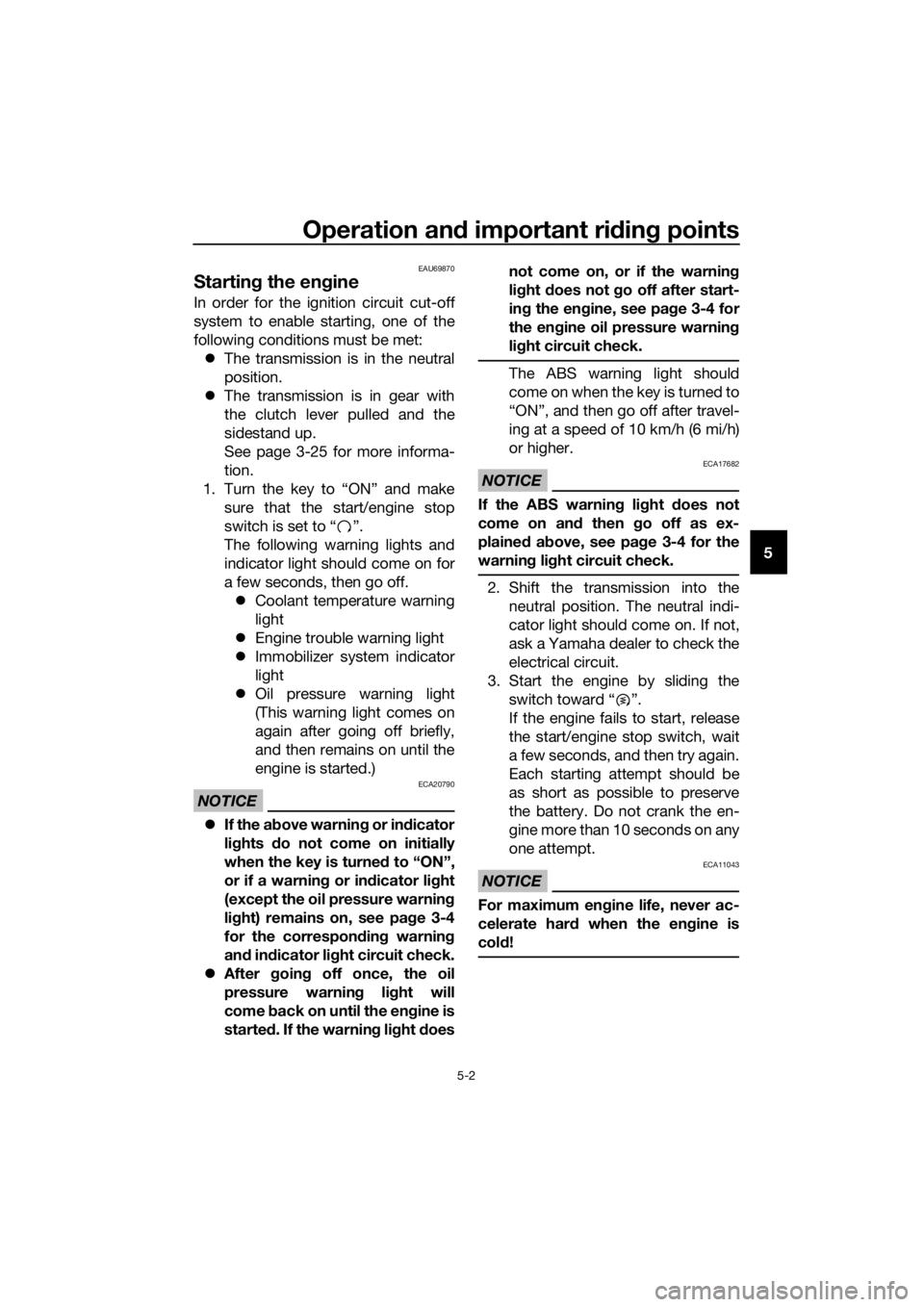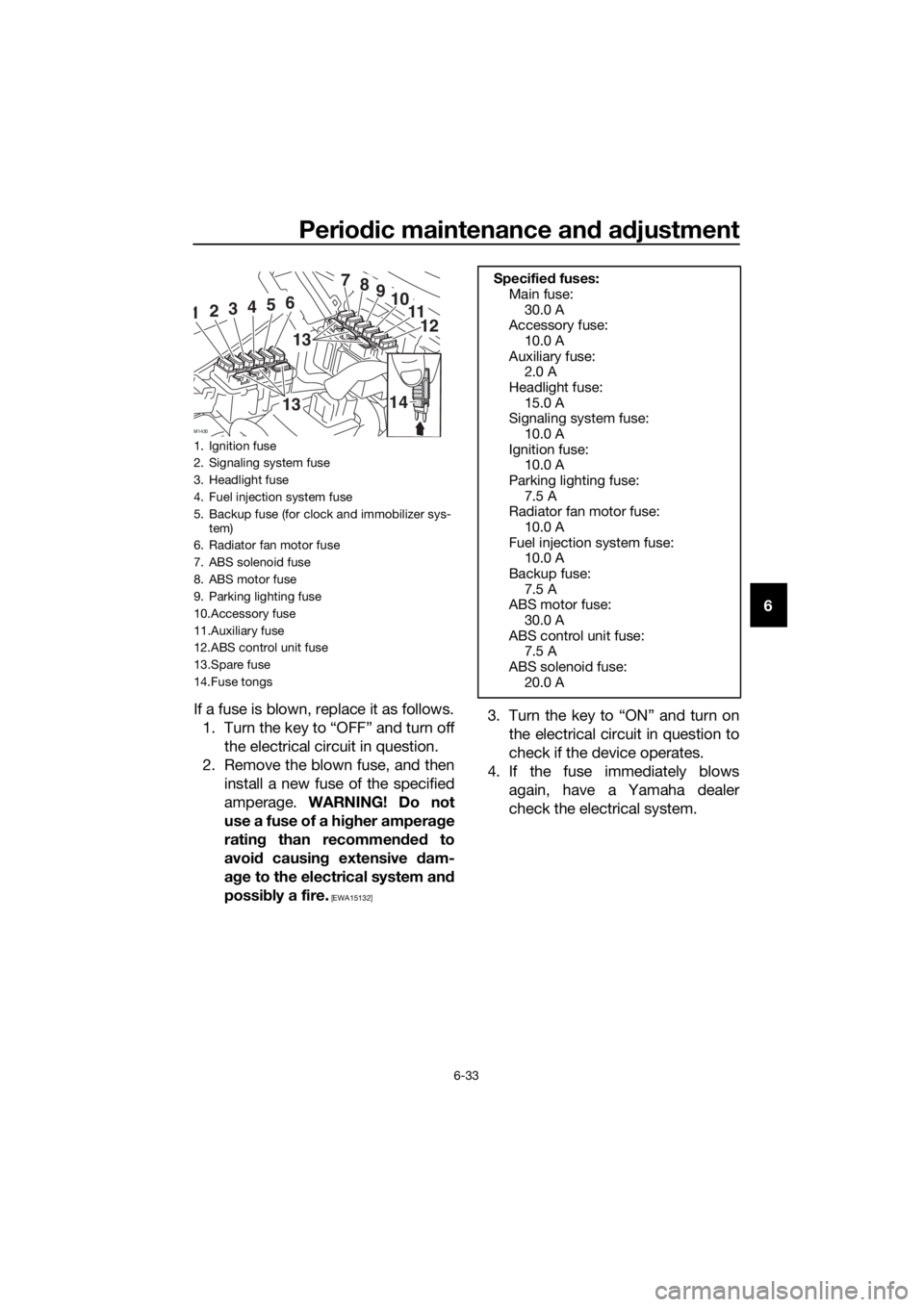immobilizer YAMAHA TRACER 700 2017 Owners Manual
[x] Cancel search | Manufacturer: YAMAHA, Model Year: 2017, Model line: TRACER 700, Model: YAMAHA TRACER 700 2017Pages: 102, PDF Size: 5.6 MB
Page 2 of 102

EAU81560
Read this manual carefully before operating this vehicle. This manual
should stay with this vehicle if it is sold.
EAU81570
Declaration of Conformity:
Hereby, YAMAHA MOTOR ELECTRONICS Co., Ltd declares that the radio equip-
ment type, IMMOBILIZER, 1WS-00 is in compliance with Directive 2014/53/EU.
The full text of the EU declaration of conformity is available at the following inter-
net address:
https://global.yamaha-motor.com/eu_doc/
Frequency band: 134.2 kHz
The maximum radio frequency power: 49.0 [dBμV/m]
Manufacturer:
YAMAHA MOTOR ELECTRONICS Co., Ltd
1450-6 Mori, Mori-machi, Shuchi-Gun, Shizuoka, 437-0292 Japan
Importer:
YAMAHA MOTOR EUROPE N.V.
Koolhovenlaan 101, 1119 NC Schiphol-Rijk, 1117 ZN, Schiphol, the Netherlands
UBC6E2E0.book Page 1 Tuesday, July 10, 2018 6:26 PM
Page 5 of 102

Table of contents
Safety information............................1-1
Description........................................2-1
Left view ..........................................2-1
Right view........................................2-2
Controls and instruments ................2-3
Instrument and control functions....3-1
Immobilizer system .........................3-1
Main switch/steering lock ...............3-2
Indicator lights and warning
lights ............................................3-4
Multi-function meter unit .................3-7
Handlebar switches.......................3-13
Clutch lever ...................................3-14
Shift pedal .....................................3-14
Brake lever ....................................3-15
Brake pedal ...................................3-15
ABS ...............................................3-16
Fuel tank cap.................................3-17
Fuel................................................3-17
Fuel tank breather hose and
overflow hose.............................3-19
Catalytic converter ........................3-19
Seat ...............................................3-20
Helmet holding cable ....................3-21
Storage compartment ...................3-22
Windshield.....................................3-22
Adjusting the shock absorber
assembly....................................3-23
Luggage strap holders ..................3-24
Sidestand ......................................3-24
Ignition circuit cut-off system........3-25
Auxiliary DC connector .................3-27
For your safety – pre-operation
checks...............................................4-1
Operation and important riding
points.................................................5-1
Starting the engine ..........................5-2
Shifting ............................................5-3
Tips for reducing fuel
consumption ................................5-4
Engine break-in ...............................5-5
Parking ............................................5-5Periodic maintenance and
adjustment........................................ 6-1
Owner’s tool kit ............................... 6-2
Periodic maintenance chart for the
emission control system.............. 6-3
General maintenance and
lubrication chart........................... 6-4
Removing and installing
cowlings ...................................... 6-7
Checking the spark plugs ............... 6-8
Canister........................................... 6-9
Engine oil and oil filter cartridge ..... 6-9
Coolant ......................................... 6-12
Replacing the air filter element
and cleaning the check hose..... 6-15
Checking the throttle grip free
play ............................................ 6-15
Valve clearance ............................. 6-16
Tires .............................................. 6-16
Cast wheels .................................. 6-19
Adjusting the clutch lever free
play ............................................ 6-19
Checking the brake lever free
play ............................................ 6-20
Brake light switches ...................... 6-21
Checking the front and rear brake
pads........................................... 6-21
Checking the brake fluid level....... 6-22
Changing the brake fluid............... 6-23
Drive chain slack ........................... 6-24
Cleaning and lubricating the drive
chain .......................................... 6-25
Checking and lubricating the
cables ........................................ 6-26
Checking and lubricating the
throttle grip and cable ............... 6-26
Checking and lubricating the
brake and shift pedals ............... 6-27
Checking and lubricating the
brake and clutch levers ............. 6-27
Checking and lubricating the
sidestand ................................... 6-28
Lubricating the rear suspension ... 6-28
Lubricating the swingarm pivots... 6-29
Checking the front fork ................. 6-29
Checking the steering ................... 6-30
UBC6E2E0.book Page 1 Tuesday, July 10, 2018 6:26 PM
Page 15 of 102

Instrument and control functions
3-1
3
EAU10978
Immobilizer system
This vehicle is equipped with an immo-
bilizer system to help prevent theft by
re-registering codes in the standard
keys. This system consists of the fol-
lowing:
a code re-registering key (with a
red bow)
two standard keys (with a black
bow) that can be re-registered
with new codes
a transponder (which is installed in
the code re-registering key)
an immobilizer unit
an ECU
an immobilizer system indicator
light (See page 3-6.)
The key with the red bow is used to
register codes in each standard key.
Since re-registering is a difficult pro-
cess, take the vehicle along with all
three keys to a Yamaha dealer to have
them re-registered. Do not use the key
with the red bow for driving. It should
only be used for re-registering the
standard keys. Always use a standard
key for driving.
NOTICE
ECA11822
DO NOT LOSE THE CODE RE-
REGISTERING KEY! CONTACT
YOUR DEALER IMMEDIATELY
IF IT IS LOST! If the code re-reg-
istering key is lost, registering
new codes in the standard keys
is impossible. The standard
keys can still be used to start
the vehicle, however if code re-
registering is required (i.e., if a
new standard key is made or all
keys are lost) the entire immobi-
lizer system must be replaced.
Therefore, it is highly recom-
mended to use either standard
key and keep the code re-regis-
tering key in a safe place.
Do not submerse any key in wa-
ter.
Do not expose any key to exces-
sively high temperatures.
Do not place any key close to
magnets (this includes, but not
limited to, products such as
speakers, etc.).
Do not place items that transmit
electrical signals close to any
key.
Do not place heavy items on any
key.
Do not grind any key or alter its
shape.
Do not disassemble the plastic
part of any key.
Do not put two keys of any im-
mobilizer system on the same
key ring.
1. Code re-registering key (red bow)
2. Standard keys (black bow)
UBC6E2E0.book Page 1 Tuesday, July 10, 2018 6:26 PM
Page 16 of 102

Instrument and control functions
3-2
3Keep the standard keys as well
as keys of other immobilizer
systems away from this vehi-
cle’s code re-registering key.
Keep other immobilizer system
keys away from the main switch
as they may cause signal inter-
ference.
EAU10474
Main switch/steering lock
The main switch/steering lock controls
the ignition and lighting systems, and is
used to lock the steering. The various
positions are described below.
TIP
Be sure to use the standard key (black
bow) for regular use of the vehicle. To
minimize the risk of losing the code re-
registering key (red bow), keep it in a
safe place and only use it for code re-
registering.
EAU38531ON
All electrical circuits are supplied with
power; the meter lighting, taillight, li-
cense plate light and auxiliary light
come on, and the engine can be start-
ed. The key cannot be removed.
TIP
The headlight comes on automatically
when the engine is started and stays
even if the engine stalls.
EAU10662OFF
All electrical systems are off. The key
can be removed.
P
ON
OFF
LOCK
UBC6E2E0.book Page 2 Tuesday, July 10, 2018 6:26 PM
Page 18 of 102

Instrument and control functions
3-4
3
EAU49399
Indicator lights and warning
lights
EAU11032Turn signal indicator lights “ ”
and“”
Each indicator light will flash when its
corresponding turn signal lights are
flashing.
EAU11061Neutral indicator light “ ”
This indicator light comes on when the
transmission is in the neutral position.
EAU11081High beam indicator light “ ”
This indicator light comes on when the
high beam of the headlight is switched
on.
EAU59962Oil pressure warning light “ ”
This warning light comes on if the en-
gine oil pressure is low.The electrical circuit of the warning
light can be checked by turning the key
to “ON”. The warning light should
come on again after going off briefly,
and then remain on until the engine is
started.
If the warning light does not come on
initially when the key is turned to “ON”,
have a Yamaha dealer check the elec-
trical circuit.
NOTICE
ECA21210
If the warning light comes on when
the engine is running, stop the en-
gine immediately and check oil level.
If the oil level is below the minimum
level, add sufficient oil of the recom-
mended t y p e t o r a i s e i t u p t o t h e c o r -
rect level. If the oil pressure warning
light remains on even if the oil level
is correct, immediately turn the en-
gine off and have a Yamaha dealer
check the vehicle.
TIP
If the warning light does not go off after
starting the engine, check the engine
oil level and add oil if necessary. (See
page 6-9.)
If the warning light remains on after
adding engine oil, have a Yamaha
dealer check the vehicle.
EAU11447Coolant temperature warning
light “ ”
This warning light comes on if the en-
gine overheats. If this occurs, stop the
engine immediately and allow the en-
gine to cool.
1. Left turn signal indicator light “ ”
2. Oil pressure warning light “ ”
3. Coolant temperature warning light “ ”
4. Engine trouble warning light “ ”
5. Anti-lock Brake System (ABS) warning
light “ ”
6. Immobilizer system indicator light “ ”
7. High beam indicator light “ ”
8. Neutral indicator light “ ”
9. Right turn signal indicator light “ ”
123456789
ABS
UBC6E2E0.book Page 4 Tuesday, July 10, 2018 6:26 PM
Page 20 of 102

Instrument and control functions
3-6
3
EAUM3621Immobilizer system indicator
light “ ”
When the key is turned to “OFF” and
30 seconds have passed, the indicator
light will flash steadily to indicate the
immobilizer system is enabled. After 24
hours have passed, the indicator light
will stop flashing, however the immobi-
lizer system is still enabled.
The electrical circuit of the indicator
light can be checked by turning the key
to “ON”. The indicator light should
come on for a few seconds, and then
go off.
If the indicator light does not come on
initially when the key is turned to “ON”,
if the indicator light remains on, or if the
indicator light flashes in a pattern (if a
problem is detected in the immobilizer
system, the immobilizer system indica-
tor light will flash in a pattern), have a
Yamaha dealer check the vehicle.
TIP
If the immobilizer system indicator light
flashes in the pattern, slowly 5 times
then quickly 2 times, this could be
caused by transponder interference. If
this occurs, try the following.
1. Make sure there are no other im-
mobilizer keys close to the main
switch. Other immobilizer system
keys may cause signal interfer-
ence and prevent the engine from
starting.
2. Use the code re-registering key to
start the engine.
3. If the engine starts, turn it off, and
try starting the engine with the
standard keys.4. If one or both of the standard keys
do not start the engine, take the
vehicle and all 3 keys to a Yamaha
dealer to have the standard keys
re-registered.
UBC6E2E0.book Page 6 Tuesday, July 10, 2018 6:26 PM
Page 45 of 102

Operation and important riding points
5-2
5
EAU69870
Starting the engine
In order for the ignition circuit cut-off
system to enable starting, one of the
following conditions must be met:
The transmission is in the neutral
position.
The transmission is in gear with
the clutch lever pulled and the
sidestand up.
See page 3-25 for more informa-
tion.
1. Turn the key to “ON” and make
sure that the start/engine stop
switch is set to “ ”.
The following warning lights and
indicator light should come on for
a few seconds, then go off.
Coolant temperature warning
light
Engine trouble warning light
Immobilizer system indicator
light
Oil pressure warning light
(This warning light comes on
again after going off briefly,
and then remains on until the
engine is started.)
NOTICE
ECA20790
If the above warning or indicator
lights do not come on initially
when the key is turned to “ON”,
or if a warning or indicator light
(except the oil pressure warning
light) remains on, see page 3-4
for the corresponding warning
and indicator light circuit check.
After going off once, the oil
pressure warning light will
come back on until the engine is
started. If the warning light doesnot come on, or if the warning
light does not go off after start-
ing the engine, see page 3-4 for
the engine oil pressure warning
light circuit check.
The ABS warning light should
come on when the key is turned to
“ON”, and then go off after travel-
ing at a speed of 10 km/h (6 mi/h)
or higher.
NOTICE
ECA17682
If the ABS warning light does not
come on and then go off as ex-
plained above, see page 3-4 for the
warning light circuit check.
2. Shift the transmission into the
neutral position. The neutral indi-
cator light should come on. If not,
ask a Yamaha dealer to check the
electrical circuit.
3. Start the engine by sliding the
switch toward “ ”.
If the engine fails to start, release
the start/engine stop switch, wait
a few seconds, and then try again.
Each starting attempt should be
as short as possible to preserve
the battery. Do not crank the en-
gine more than 10 seconds on any
one attempt.
NOTICE
ECA11043
For maximum engine life, never ac-
celerate hard when the engine is
cold!
UBC6E2E0.book Page 2 Tuesday, July 10, 2018 6:26 PM
Page 81 of 102

Periodic maintenance and adjustment
6-33
6
If a fuse is blown, replace it as follows.
1. Turn the key to “OFF” and turn off
the electrical circuit in question.
2. Remove the blown fuse, and then
install a new fuse of the specified
amperage. WARNING! Do not
use a fuse of a higher amperage
rating than recommended to
avoid causing extensive dam-
age to the electrical system and
possibly a fire.
[EWA15132]
3. Turn the key to “ON” and turn on
the electrical circuit in question to
check if the device operates.
4. If the fuse immediately blows
again, have a Yamaha dealer
check the electrical system.
1. Ignition fuse
2. Signaling system fuse
3. Headlight fuse
4. Fuel injection system fuse
5. Backup fuse (for clock and immobilizer sys-
tem)
6. Radiator fan motor fuse
7. ABS solenoid fuse
8. ABS motor fuse
9. Parking lighting fuse
10.Accessory fuse
11.Auxiliary fuse
12.ABS control unit fuse
13.Spare fuse
14.Fuse tongs
M1430
789
11
12123456
13
1310
14
Specified fuses:
Main fuse:
30.0 A
Accessory fuse:
10.0 A
Auxiliary fuse:
2.0 A
Headlight fuse:
15.0 A
Signaling system fuse:
10.0 A
Ignition fuse:
10.0 A
Parking lighting fuse:
7.5 A
Radiator fan motor fuse:
10.0 A
Fuel injection system fuse:
10.0 A
Backup fuse:
7.5 A
ABS motor fuse:
30.0 A
ABS control unit fuse:
7.5 A
ABS solenoid fuse:
20.0 A
UBC6E2E0.book Page 33 Tuesday, July 10, 2018 6:26 PM
Page 96 of 102

Specifications
8-3
8
Brake/tail light:
LED
Front turn signal light:
10.0 W × 2
Rear turn signal light:
10.0 W × 2
Auxiliary light:
LED
License plate light:
5.0 W × 1
Meter lighting:
LED
Neutral indicator light:
LED
High beam indicator light:
LED
Oil pressure warning light:
LED
Turn signal indicator light:
LED
Coolant temperature warning light:
LED
Engine trouble warning light:
LED
ABS warning light:
LED
Immobilizer system indicator light:
LED
Fuse(s):
Main fuse:
30.0 A
Accessory fuse:
10.0 A
Auxiliary fuse:
2.0 A
Headlight fuse:
15.0 A
Signaling system fuse:
10.0 A
Ignition fuse:
10.0 A
Parking lighting fuse:
7.5 A
Radiator fan motor fuse:
10.0 A
Fuel injection system fuse:
10.0 A
ABS control unit fuse:
7.5 A
ABS motor fuse:
30.0 AABS solenoid fuse:
20.0 A
Backup fuse:
7.5 A
UBC6E2E0.book Page 3 Tuesday, July 10, 2018 6:26 PM
Page 99 of 102

10-1
10
Index
A
ABS ...................................................... 3-16
ABS warning light ................................... 3-5
Air filter element and check hose,
replacing and cleaning ....................... 6-15
Auxiliary DC connector ........................ 3-27
Auxiliary lights ...................................... 6-35
B
Battery .................................................. 6-31
Brake and clutch levers, checking and
lubricating .......................................... 6-27
Brake and shift pedals, checking and
lubricating .......................................... 6-27
Brake fluid, changing ........................... 6-23
Brake fluid level, checking ................... 6-22
Brake lever ........................................... 3-15
Brake lever free play, checking ............ 6-20
Brake light switches ............................. 6-21
Brake pedal .......................................... 3-15
Brake/tail light ...................................... 6-36
C
Cables, checking and lubricating ......... 6-26
Canister .................................................. 6-9
Care ........................................................ 7-1
Catalytic converter ............................... 3-19
Clutch lever .......................................... 3-14
Clutch lever free play, adjusting ........... 6-19
Coolant ................................................. 6-12
Coolant temperature warning light ......... 3-4
Cowlings, removing and installing ......... 6-7
D
Data recording, vehicle .......................... 9-2
Diagnostic connector ............................. 9-2
Dimmer switch ..................................... 3-13
Drive chain, cleaning and lubricating ... 6-25
Drive chain slack .................................. 6-24
E
Engine break-in ...................................... 5-5
Engine oil and oil filter cartridge ............. 6-9
Engine serial number.............................. 9-1
Engine trouble warning light................... 3-5
F
Front and rear brake pads, checking ... 6-21
Front fork, checking ............................. 6-29
Fuel....................................................... 3-17
Fuel consumption, tips for reducing ...... 5-4
Fuel tank breather hose and overflow
hose ................................................... 3-19
Fuel tank cap........................................ 3-17
Fuses, replacing ................................... 6-32
H
Handlebar switches .............................. 3-13
Hazard switch ....................................... 3-13
Headlight bulb, replacing ...................... 6-34
Helmet holding cable ............................ 3-21
High beam indicator light........................ 3-4
Horn switch........................................... 3-13
I
Identification numbers ............................ 9-1
Ignition circuit cut-off system ............... 3-25
Immobilizer system ................................. 3-1
Immobilizer system indicator light .......... 3-6
Indicator lights and warning lights .......... 3-4
L
License plate light bulb, replacing ........ 6-37
Luggage strap holders .......................... 3-24
M
Main switch/steering lock ....................... 3-2
Maintenance and lubrication, periodic ... 6-4
Maintenance, emission control
system .................................................. 6-3
Matte color, caution ................................ 7-1
Model label ............................................. 9-1
Multi-function meter unit ........................ 3-7
N
Neutral indicator light.............................. 3-4
O
Oil pressure warning light ....................... 3-4
P
Parking .................................................... 5-5
Part locations .......................................... 2-1
Pass switch........................................... 3-13
R
Rear suspension, lubricating ................ 6-28
S
Safety information................................... 1-1
Seat....................................................... 3-20
Shifting .................................................... 5-3
Shift pedal............................................. 3-14
Shock absorber assembly, adjusting ... 3-23
Sidestand .............................................. 3-24
Sidestand, checking and lubricating .... 6-28
Spark plugs, checking ............................ 6-8
Specifications ......................................... 8-1
Start/Engine stop switch ...................... 3-13
Starting the engine.................................. 5-2
Steering, checking ................................ 6-30
Storage ................................................... 7-4
Storage compartment ........................... 3-22
Supporting the motorcycle ................... 6-37
UBC6E2E0.book Page 1 Tuesday, July 10, 2018 6:26 PM